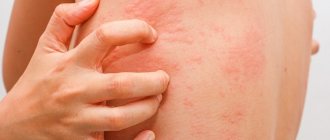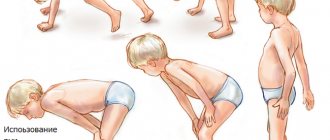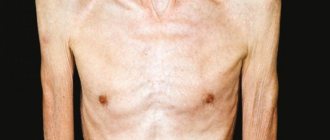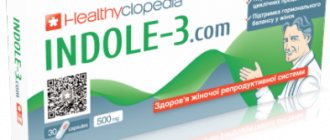Herpes zoster, symptoms and treatment in adults
Herpes zoster is an extremely unpleasant and fairly common disease of a viral nature. Symptoms of the disease appear in different parts of the body. Usually this is the face, limbs, genitals, lumbar back. Sometimes rashes form on other areas of the skin, but on the face most often.
This disease also has certain signs of damage to the nervous system. In addition to shingles, the causative agent of the disease - varicella zoster - can lead to the appearance of chickenpox in children, as well as adults who have not previously suffered from this disease.
What it is?
Herpes zoster is a sporadic disease caused by reactivation of the herpes virus type III (Varicella Zoster virus). The disease is characterized by primary damage to the skin and nervous system with severe complications.
When varicella-zoster viruses enter the human body, they quickly spread through the blood, cerebrospinal fluid and nerve sheaths. Settling in the nerve cells of the spinal ganglia, they persist there for life. Hypothermia, insolation, alcohol abuse, physical and mental trauma, hormonal cycles - everything that attacks the immune system provokes an exacerbation of the disease. Having a tropism for cells of the nervous system, varicella-zoster viruses cause diseases that often occur as an infectious disease of the central and peripheral nervous systems.
Lifelong latent carriage of varicella zoster has been established in approximately 20% of residents of our country who had chickenpox in childhood. Asymptomatic carriage of a “dormant” virus can be lifelong. The main refuge for it is the nerve cells of the body. Under the influence of internal and/or external agents, the virus is activated.
Can shingles be washed?
During illness, due to damage to the skin, patients are prohibited from taking a bath or shower, or visiting a sauna or swimming pool. At the same time, it is important to continue to maintain personal hygiene, otherwise the risk of infection of the vesicles with bacterial flora increases.
Therefore, dermatologists recommend:
- regularly use antiseptic ointments and solutions to treat rashes;
- change underwear daily;
- update bed linen with antiseptic treatment - washing at high temperatures and ironing.
It is necessary to avoid synthetic, tight and dense clothing that interferes with skin respiration and can damage the vesicles. After all the bubbles have dried, you can resume normal hygiene procedures, and also take salt baths as an additional method of therapy in consultation with your doctor.
Story
Shingles was known in ancient times, but was considered as an independent disease. At the same time, chickenpox was often mistaken for smallpox for a long time: despite the fact that the clinical differences between these two infections were described back in the 60s of the 18th century, reliable differentiation became possible only at the end of the 19th century.
The infectious nature of chickenpox was proven by Steiner in 1875 in experiments on volunteers. Assumptions about the connection between chickenpox and herpes zoster were first made in 1888 by von Bokay, who observed chickenpox in children after contact with patients with herpes zoster. These ideas were confirmed only in the late 1950s, when T. Weller isolated the pathogen from patients with both clinical forms of infection.
However, epidemiological data turned out to be the most convincing: the incidence of chickenpox in areas of herpes zoster was significantly higher than the average among the population (in areas of herpes zoster the secondary risk of infection is high). In 1974, Takahashi and his colleagues obtained a weakened Oka strain of the “wild” virus, and in 1980 a clinical trial of a vaccine against chickenpox was started in the United States.
Complications of herpes zoster
The most common complication of herpes zoster is neuralgia (postherpetic neuralgia - PHN). This is chronic pain located at the site of the rash. The basis for diagnosing neuralgia is persistent pain despite the disappearance of the rash. Diagnostic criteria for postherpetic neuralgia require pain to persist for a period longer than 30 days or more than 90 days after the onset of the rash. Patients suffering from neuralgia feel severe pain for a long time - up to several months, or even several years. The pain associated with postherpetic neuralgia can be severe and lead to significant reductions in quality of life and impairment of functioning. Although most patients' pain goes away within a few weeks to months, some people may continue to have pain for several years. In approximately 10% (1/10) of patients, pain after herpes persists for at least 90 days. In the United States, postherpetic neuralgia is reported as the fifth most common cause of suicide among older adults.
The risk of neuralgia after suffering from herpes zoster increases with age. Older people are more susceptible to neuralgia and complain of longer and more severe pain. Neuralgia after herpes occurs rarely among people under 40 years of age. According to one study, the risk of developing neuralgia after herpes is: 5% at ages 22–59, 10% at ages 60–69, and 17% at ages 70–79, increasing to 20% at ages over 80. Other unfavorable prognostic factors for postherpetic neuralgia include: significant intensity of pain during the appearance of a herpetic rash, the appearance of precursors, ophthalmic herpes zoster, as well as a large surface area occupied by the rash.
A severe clinical course of herpes zoster is possible. A hemorrhagic form has been described, occurring with skin hemorrhages, as well as a gangrenous form, in which the destruction of skin changes occurs, leaving hagrenous ulcers. People with severe immune disorders may develop a generalized (disseminated) form, in which skin changes are scattered throughout the body.
Herpes zoster can lead to serious complications related to its location. Involvement of the first branch of the trigeminal nerve results in vision-threatening herpes zoster ophthalmicus. If the auditory nerve (n. VIII) is damaged, hearing impairment may occur. Rarely, herpes zoster affects the nerves that innervate the spinal cord, leading to the development of meningitis. A complication of herpes zoster affecting the visceral nerves is damage to internal organs, which can be accompanied by pneumonia, hepatitis, and also lead to the development of acute necrosis of internal organs. Very rarely, shingles can also lead to encephalitis.
Other complications of herpes zoster include bacterial superinfection of skin lesions, usually caused by staphylococci (Staphylococcus aureus), less commonly by streptococci (group A beta-hemolytic streptococci), and paralysis of the peripheral and cranial nerves involved in the disease process.
Patients with weakened immune systems or those receiving immunosuppressive medications are more likely to develop complications of herpes zoster. Typically, the rash is also more severe and lasts longer. Immunosuppressed patients are at increased risk of developing disseminated herpes zoster.
About 1–4% of people with herpes zoster require hospitalization due to complications of herpes zoster. Elderly people and patients with reduced immunity are at increased risk of hospitalization.
How can you get infected?
The herpes zoster virus is highly contagious (transmissible), so it easily spreads from person to person through airborne droplets, as well as through contact with the skin of a patient. In this case, the liquid contained in the bubbles formed on the epidermis of those infected with chickenpox or shingles penetrates into the body. For the first time, an infected person becomes ill with chickenpox, after which the virus persists in the body for a long time.
An exacerbation of the disease in the form of herpes zoster can occur due to exposure to a number of provoking factors:
- decreased immunity, severe immunodeficiency states;
- taking cytostatics, chemotherapy, cancer;
- autoimmune diseases, pathological disorders in the blood;
- stress, shock;
- poisoning, intoxication;
- prolonged hypothermia;
- old age (over 65 years).
Chickenpox is a common disease in children, and an adult with a history of this disease can activate the dormant virus by contact with the child. Herpes zoster in children under 10 years of age can occur only in the case of congenital disorders of the functioning of cells of the immune system, as well as in cases of chickenpox in the first months of life.
Shingles (Herpes zoster)
Herpes
22245 August 26
IMPORTANT!
The information in this section cannot be used for self-diagnosis and self-treatment.
In case of pain or other exacerbation of the disease, diagnostic tests should be prescribed only by the attending physician. To make a diagnosis and properly prescribe treatment, you should contact your doctor. Shingles (Herpes zoster): causes, symptoms, diagnosis and treatment methods.
Shingles is an infectious disease whose causative agent (herpes virus type 3) also causes chickenpox.
Since the virus, penetrating the sensitive nerve endings, is integrated into the genetic apparatus of nerve cells, it is impossible to remove it from the body. In people who have had chickenpox, the virus enters a latent (inactive) state.
When the immune system is weakened, the virus becomes more active, affecting the skin. The disease most often develops in the elderly and in people with immunodeficiency.
Causes of the disease
The virus is transmitted from a patient with chickenpox or shingles by contact or airborne droplets. The person who becomes infected initially (most often a child) gets chickenpox. Penetrating through the mucous membranes into the blood and lymph, the virus reaches nerve cells, where it begins to multiply. After recovery, the virus remains in the body for life, often remaining in an inactive state. The awakening of the infection is associated with a weakening of the immune system caused by hypothermia, long-term use of steroid hormonal drugs, immunosuppression (after transplantation), chemotherapy and radiation therapy, as well as a general decrease in immunity in patients with blood diseases, cancer and viral diseases. Herpes zoster is very severe in HIV-infected patients.
Classification of herpes zoster
The clinical picture of herpes zoster consists of skin manifestations and neurological disorders. There are typical and atypical forms of the disease. In the atypical form, an erased course of the disease is possible, in which papules develop in the foci of hyperemia, which do not transform into vesicles.
With herpes zoster, the spread of the pathological process corresponds to a specific area of the skin and does not cross the anatomical midline of the body. In most patients, the appearance of a rash is preceded by a burning or itching sensation in a certain area of the skin, as well as pain, which can be stabbing, throbbing, shooting, paroxysmal or constant. In a number of patients, the pain syndrome is accompanied by general systemic inflammatory manifestations: fever, malaise, myalgia, headache.
Infection of the central nervous system and damage to the meninges can give rise to meningeal, encephalic (symptoms indicate damage by the virus to the brain and/or spinal cord and meninges) or mixed forms of herpes zoster. If the infection spreads along the optic nerve, ophthalmoherpes develops.
When a rash appears over the entire surface of the skin and on parenchymal organs (for example, liver, kidneys), a generalized form of herpes zoster develops. Another type of herpes zoster is hemorrhagic. A characteristic sign is bloody fluid inside the blisters.
Symptoms of herpes zoster
The onset of the disease is accompanied by general intoxication, malaise and fever. Nausea and vomiting are possible. Lymph nodes enlarge.
Severe pain appears along the affected nerve, which can be constant, but more often has a paroxysmal itchy nature, intensifying at night.
They are usually provoked by any irritants: touching the skin, cold, movement. Some patients complain of loss of sensation in certain areas of the skin, which may be accompanied by an increased pain response. Sometimes the pain syndrome in the absence of skin rashes may resemble angina pectoris, myocardial infarction, renal colic or pancreatitis. The period of neuralgia preceding the rash lasts up to 7 days. Then nodules appear on one side of the body, from which bubbles with transparent contents are formed, which gradually become cloudy. After 3-7 days, most of the bubbles dry out with the formation of yellow-brown crusts. When the vesicles are injured, bright red ulcers are exposed. After the sores heal, small scabs or scars remain on the skin.
Most often, rash and pain are observed in the ribs, lower back and sacrum, less often along the branches of the trigeminal, facial and auricular nerves and on the extremities.
In rare cases, mucous membranes are affected.
Diagnosis of herpes zoster
A diagnosis can be made after examining and interviewing the patient. The doctor pays attention to the nature of the rash (localized and unilateral), the type of blisters and complaints of itchy, burning pain. It is more difficult to identify the atypical form of herpes zoster. In the erased form, pain and other neurological symptoms may be absent. For neurogenic disorders, before the appearance of rashes, a diagnosis can be made based on the results of laboratory tests. In this case, histological examination is used, and the virus is isolated in cell culture. The Tzanck test helps quickly confirm the herpetic nature of the rash: in a scraping of material taken from the base of the vesicle, giant multinucleated cells are detected. However, this test cannot determine the type of herpes. Methods of enzyme immunoassay and indirect immunofluorescence reaction are also used. Recently, viral infections have been diagnosed using polymerase chain reaction (PCR).
Is herpes zoster contagious?
If a contact person had chickenpox in childhood and has developed a strong immunity, then the risk of contracting herpes zoster is practically reduced to a minimum. However, in people who have not previously had chickenpox, contact with someone with shingles can lead to the development of chickenpox. This risk especially increases in children and adults over fifty years of age with low immunity.
It should be noted that herpes zoster is contagious during the period of herpetic rashes. During the period of healing and formation of crusts, this disease ceases to be dangerous.
Where does shingles occur?
The location of the rash depends on which nerve is affected. The rash may appear on the face, torso, and limbs, but usually only on one side of the body: for example, only on the back or only on the stomach. If vesicles appear on both sides, this indicates a rare generalized form of herpes zoster.
The rash may also affect:
- ears;
- mucous membrane of the mouth and nose;
- conjunctiva of the eyes;
- external genitalia, including the vulva in women.
If bubbles appear on the mucous membranes, they quickly burst with the formation of areas of erosion.
Is it possible to get sick again?
When the varicella zoster virus enters the human body, it causes chickenpox (varicella). However, after recovery, this virus is not eliminated, but remains in the human body in a latent state. This virus lurks asymptomatically in nerve cells in the dorsal roots of the spinal cord.
Activation of the virus occurs when the body is exposed to negative factors that contribute to a decrease in immunity. In this case, the disease recurs, only not in the form of chickenpox, but in the form of herpes zoster. As a rule, re-occurrence of shingles is not observed in the future. In patients with normal health, relapse of herpes zoster is observed in two percent of cases.
In ten percent of people, a relapse of herpes zoster is observed in the presence of the following pathologies:
- HIV infection;
- AIDS;
- oncological diseases;
- diabetes;
- lymphocytic leukemia
In this regard, to reduce the risk of relapse of the disease, as well as to prevent the development of herpes zoster, a vaccine against the Varicella-zoster virus was released in 2006. This vaccine showed good results, reducing the risk of developing the disease by 51%.
Herpes zoster: symptoms, complications, treatment
27.01.2021
Shingles is caused by the varicella zoster virus, which is also responsible for chickenpox. This occurs due to the reactivation of the varicella zoster virus, which remains in the body's nerve cells after an attack of chickenpox.
People who get chickenpox are at risk of developing shingles later in life because the virus lies dormant in the body. Fortunately, it is rare to have more than one attack of shingles .
Anyone who has had chickenpox may develop shingles . However, people who have never had chickenpox can get it from a person with shingles . A person who has never had chickenpox but is exposed to someone with shingles may develop chickenpox (not shingles ).
Symptoms
Shingles skin rash characterized by pain and blisters that usually appears on one side of the face or body. Tender, sore skin, fatigue, headache and photophobia may occur 2-3 days before the skin turns red and tiny fluid-filled blisters form.
Shingles can affect any part of the body, including the face . Classically, the rash caused by herpes zoster often takes the form of a belt on one side of the body. The thoracic and lumbar regions are most often affected.
The rash usually lasts from 10 to 15 days. At this time, a scaly crust may appear. Once the attack is over, the skin usually returns to normal, but in severe cases there may be scarring or a secondary bacterial infection.
How is shingles spread?
Shingles can spread when a person comes into contact with the fluid contained in the blisters . The virus can be transmitted by direct contact with the lesions or by touching any bandages, sheets or clothing contaminated with discharge from the blisters.
Shingles, chicken pox and pregnancy
A bout of shingles during pregnancy will not harm your unborn baby. varicella zoster virus before herpes zoster develops , and there is no risk of passing it on to the fetus if herpes zoster develops. However, a bout of chickenpox during pregnancy can be serious and requires help.
Postherpetic neuralgia
Sometimes the pain does not go away after recovery from shingles . This constant pain in the area where the rash has been present for longer than 3 months is called postherpetic neuralgia . Painkillers or nerve pain-specific tablets may be needed to relieve symptoms.
Treatment
Antiviral medications may help relieve pain and shorten the attack of shingles . The drug works best if taken within three days, and ideally within 24 hours of the rash appearing. If you think you have shingles , get emergency medical help. Pain medication may also relieve postherpetic neuralgia , but check with your doctor .
Published in Dermatology Premium Clinic
Initial period
Prodromal, characterized by general malaise, neuralgic pain of varying intensity, this lasts on average 2-4 days:
- Headache
- Low-grade body temperature, less often fever up to 39C
- Chills, weakness
- Dyspeptic disorders, gastrointestinal dysfunction
- Pain, itching, burning, tingling in the area of the peripheral nerves in the area where the rash will later appear.
- Most often, during an acute process, regional lymph nodes become painful and enlarged.
- In severe cases of the disease, urinary retention and other disorders of certain systems and organs may occur.
After the temperature decreases, other general intoxication disorders also weaken.
Period of rash
The time when rashes characteristic of shingles appear. The symptoms and nature of the rash depend on the severity of the inflammatory process. At first, the rashes look like pockets of pink spots 2-5 mm in size, between which there are areas of healthy skin.
- In the typical form of the disease, the next day, small, closely grouped vesicles and vesicles with transparent serous contents form in their place, which becomes cloudy after 3-4 days.
- In severe gangrenous form of herpes, the contents of the vesicles may be mixed with blood and black in color. Herpetic rashes have a wave-like course, as with chickenpox, that is, fresh rashes with vesicular elements appear at intervals of several days. The bubbles seem to crawl from one place to another, encircling the body, hence the name of this disease.
In mild forms of the inflammatory process, the transformation of skin nodules into pustules does not form and their ulceration does not occur, and the manifestation of herpes is also possible only of a neurological nature - pain without a rash, otherwise it is also called herpetic neuralgia and is often mistaken for manifestations of intercostal neuralgia, osteochondrosis or heart pain. And therefore, inadequate treatment may be prescribed.
What is shingles?
Shingles is a common viral disease diagnosed in people who have previously had chickenpox (chickenpox). The infection occurs more often in older people, which is associated with an age-related decrease in immune defense.
The development of shingles can be triggered by:
- uncontrolled medication use;
- radio and chemotherapy;
- hypovitaminosis;
- intense physical or mental stress;
- unfavorable environmental situation;
- prolonged exposure to allergens or toxic substances (for example, at work);
- a sharp change in climate zone;
- hypothermia of the body;
- chronic diseases, for example, diabetes, stomach ulcers;
- undergone surgical operations.
The risk of developing herpes zoster is higher among people suffering from autoimmune diseases and cancer.
The symptoms of the disease depend on its stage and the individual characteristics of the patient’s body. The incubation period can last decades, after which the virus is activated against the background of previous injuries, acute infections or other factors that weaken the immune system.
In a latent state, the pathogen is located in the spinal cord, but when the body’s defenses decrease, it begins to actively multiply and infect surrounding tissues. As a rule, the virus “moves” along the nerve endings to the skin, where it manifests itself in the form of a characteristic rash. At the same time, the infection spreads throughout the nervous system, including the brain, which causes attacks of pain and symptoms of general intoxication.
The first signs of shingles are:
- malaise and general weakness;
- increased fatigue;
- fever;
- headache;
- loss of appetite accompanied by nausea, in severe cases with vomiting.
After a few days, characteristic pain appears in the affected area of the skin. Painful sensations can be of varying intensity, intensify when touched, and be accompanied by itching.
In this case, the symptoms change, the following occurs:
- swelling and redness of tissues;
- rash in the form of reddish bubbles (vesicles) filled with liquid. The bubbles can grow and merge with each other.
After 3-5 days, the blisters shrink and disappear, often with the formation of scars.
Dermatologists distinguish several types of atypical shingles, in which the manifestations of the infection change:
- abortive - characterized by the absence of rash and pain, although the skin swells, but redness and swelling quickly disappear;
- bullous - instead of small blisters, the patient experiences large formations, and the symptoms of general intoxication intensify;
- hemorrhagic - the rash is filled with lymph with a large amount of blood, microhemorrhages occur in the skin, the pathological process affects the deep layers of the skin;
- gangrenous - deep and long-lasting ulcers appear at the site of the rash, the general condition of the patient is serious;
- generalized - the rash occupies up to half the body and can appear on the mucous membranes (for example, in the oral cavity).
The severity of the disease is directly related to the general state of the immune system. In older people, people suffering from severe chronic disorders, and those who have undergone radiation therapy, the infection is most acute and often leads to complications.
Pain is a terrible symptom of herpes zoster
When the disease occurs, the patient always experiences pain, the intensity of which ranges from barely perceptible to excruciating, debilitating pain, which stops for a short period under the influence of drugs. Most often, pain appears in the area of skin rashes corresponding to the affected nerves. The intensity of the pain does not always correspond to the severity of the skin rash.
After the exacerbation stops, 10-20% of patients develop postherpetic neuralgia, in which pain persists for a long time - from several months to several years. Pain is associated with viruses affecting the intervertebral ganglia of the cranial spinal nerves and dorsal roots of the spinal cord. A severe course of the disease is recorded when the spinal cord, brain, and its membranes are damaged. When the autonomic ganglia are damaged, the function of internal organs is disrupted.
Symptoms of herpes zoster
Herpes zoster is characterized by rashes along individual sensory nerves of fuzzy pinkish spots (3-5 cm in diameter), against which after 18-24 hours groups of painful vesicles form; the main feature that distinguishes them from other herpetic skin lesions is the presence of a clear demarcation zone. Most often, lesions are localized on the chest, but can also be located along any sensory nerve and, as a rule, are unilateral. The lesions disappear within 2-4 weeks, but pain (neuralgia) may persist for weeks or several months. Contagiousness: 1-2 days before the rash and until the crusts fall off. Complications include secondary bacterial skin infection, as well as encephalitis, meningitis, myocarditis, glomerulonephritis, and arthritis (rare). A very serious complication is pneumonia, which increases the risk of mortality: in adults up to 5-10%.
Atypical symptoms
Signs of herpes zoster in atypical forms of the course are expressed in the following forms:
| Gangrenous | often manifests itself in severe immunodeficiency and is characterized by an intensified rash, which, encircling the localization, constantly changes movement. This is expressed by the constant appearance of new rashes |
| Abortive | in this form, the blistering rash in the form of vesicles does not appear, but neuralgia remains. |
| Bullous | this form is expressed by the connection of vesicles located nearby into single large papules. |
| Generalized | with serious disorders of the immune system after typical rashes, herpes zoster begins to affect large areas of the skin and mucous membranes. |
| Bubble | the vesicles increase in size, are grouped and form a large area of rashes, seemingly with ragged borders of the lesion. |
Before treating shingles, you need to make sure that it is it. Until herpes zoster gives obvious symptoms, it is impossible to determine the disease, since neuralgic symptoms may indicate other diseases.
How does shingles begin?
Most people who have had chickenpox do not experience a recurrence of the infection and do not even suspect that this is possible. The signs of shingles vary depending on the form of the disease.
- Gangliocutaneous. The prodromal stage lasts about a week and is manifested by mild discomfort with minor pain in the areas where rashes will subsequently appear. Skin sensitivity may be impaired. Then the pain intensifies, and a complex of signs characteristic of the presence of an infection in the body appears. The sensitivity of areas of the skin increases so much that pain can be felt due to blowing wind. Within a week, the skin in the painful areas turns red and a rash appears in the form of blisters with transparent contents. After 4-5 days, crusts appear in place of the bubbles, which then fall off. The illness lasts from two to four weeks.
- Ocular. The onset resembles the gangliocutaneous form, but the rash is localized to the skin of the face, since the infection affects the trigeminal nerve and gasser ganglion. The rash covers the skin of the nose, surrounds the eye and extends to the forehead, continuing to the parietal region. Sometimes the eye is affected.
- Ear. The disease affects the auricle and the outer covering of the ear canal, the patient ceases to feel taste. The facial muscles and facial nerve may be paralyzed.
- Gangrenous. Due to deep damage to the skin, tissue necrosis begins. Hemorrhagic impregnation of the affected areas is possible. After healing, deep scars remain on the body. This form of the disease most often develops in older people with severe chronic illness - peptic ulcer, diabetes, etc.
- Meningoencephalitic. A severe form of the disease with high mortality develops when the nerve endings of the head are damaged. It is characterized by high fever, headaches, nausea, vomiting, and disturbances of consciousness. The patient falls into a coma.
- Disseminated. It develops against the background of HIV, affects various internal organs, and rashes spread over the entire surface of the skin.
- Ganglioneuralgic. There is only pain, without skin damage. Because of this, diagnosing herpes zoster is difficult and treatment begins late.
In any form of the disease, damage to the autonomic nerve nodes can develop, which leads to the appearance of atypical symptoms - constipation or diarrhea, urinary retention, etc.
Are you experiencing symptoms of shingles?
Only a doctor can accurately diagnose the disease. Don't delay your consultation - call
Treatment of herpes zoster
In adults, herpes zoster may resolve spontaneously and without medical intervention. However, for people with weakened immune systems and elderly patients, treatment for herpes zoster should begin as soon as possible. This allows you to alleviate the severity of the condition and prevent post-herpetic complications.
Among antiviral drugs, adult patients are prescribed tablets for 7–10 days:
- Zovirax – 2 g/day.
- Acyclovir – 0.8 g x 5 r. in a day.
- Famciclovir – 0.5 g x 3 r. in a day.
- Valaciclovir – 1 g x 3 r. per day.
To relieve pain in the initial stages of herpes zoster, the following is prescribed:
- Aspirin.
- Ibuprofen.
- Anileridine.
- Diclofenac.
- Sufentanil.
- Paracetamol.
Antidepressants for the treatment of HSV-3 with prolonged pain syndrome are prescribed as follows:
- Duloxetine.
- Citalopram.
- Mirtazapine.
- Doxepin.
- Maprotiline.
- Clomipramine.
- Escitalopram.
- Venlafaxine.
How to treat herpes zoster to eliminate specific rashes? Experts prescribe medications for external use in addition to antiviral drugs for internal use.
Effective ointments against the Zoster virus are Acyclovir, Bonafton, Alpizarin, Helepin, Interferon, Epervudine. It is useful to treat the body with Allergoferon and Infagel gels, as well as Epigen, Acyclovir, Zovirax creams.
To dry and disinfect wounds left after opening herpetic elements, it is allowed to use Castellani liquid and brilliant green, boric acid and Calamine, Fukortsin and Chlorhexidine lotions. Treatment is varied with zinc preparations (Badigeon, Tsindol) and a strong solution of potassium permanganate.
Folk remedies
All of the following recipes for plant herbs (optional) are prepared as follows: leave one tablespoon of herbs in a glass of boiling water for 20-30 minutes, cool and consume 1/2-1/3 cup 2-3 times a day to relieve mild pain and nervous excitability , as well as for insomnia.
- Valerian root, mint leaves - 3 parts each, watch leaves - 4 parts.
- Mint leaf, watch leaf - 2 parts each, valerian root and hop cones - 1 part each.
- Fennel fruits and chamomile flowers - 1 part each, marshmallow root, licorice root, wheatgrass rhizome - 2 parts each (recommended for children).
- Valerian root – 2 parts, chamomile root – 3 parts, caraway fruit – 5 parts.
- Valerian root, hawthorn flowers, mint leaves, mistletoe herb, motherwort herb - 1 part each.
- Valerian root, motherwort herb, green oat straws - 1 part each.
- Tatar leaves, green oat straw, caraway fruits - 2 parts each, hawthorn flowers, chamomile flowers - 1 part each.
- Mint leaves - 1 part, heather grass, lemon balm leaves - 2 parts each, valerian root - 4 parts.
- Heather leaves, cudweed herb, thyme herb, valerian root - 2 parts each, chicory root - 1 part.
- Motherwort grass, cudweed grass, heather grass - 2 parts each, hop cones, caraway fruits - 1 part each.
The use of medicinal pharmacopoeial herbs is justified in mild forms of the pathogenesis of herpes zoster.
Consequences
A quick and painless recovery from herpetic lichen is due to the general good health of the patient. A young and strong body with normal immunity copes better with the virus. In general, this disease rarely goes away without any complications - in only 30% of cases. Neuralgic pain after a virus infection can last from six months to several years.
The consequences of herpes zoster can be very serious:
- transverse myelitis with transition to motor paralysis;
- heart failure;
- progression of oncological processes;
- Ramsay-Hunt symptom: paralysis of facial muscles, complete or partial hearing loss;
- damage to the oculomotor nerves;
- brain lesions: encephalitis, serous meningitis, meningoencephalitis;
- blindness caused by retinal necrosis.
Improperly treated herpes zoster can develop a relapsing course with subsequent coverage of other nerve trunks. In addition to a neurologist and a skin clinic, you should definitely visit an immunologist for proper correction of immunity.
Vaccination
A live vaccine known as Zostavax has been proposed against the occurrence of the disease.
This vaccine rarely causes side effects but is contraindicated in immunocompromised patients and may not be effective in patients taking antiviral drugs active against Varicella zoster virus. From an economic point of view, it is advisable to use it for patients over 60 years of age.
A Cochrane Library systematic review of eight randomized, placebo-controlled trials involving 52,269 participants found that the Zostavax vaccine in older adults prevented one episode of herpes zoster in every 70 people vaccinated, meaning it was effective in reducing the risk of herpes zoster by almost 50%. Side effects caused by the vaccine were mainly mild to moderate symptoms at the injection site[16].










